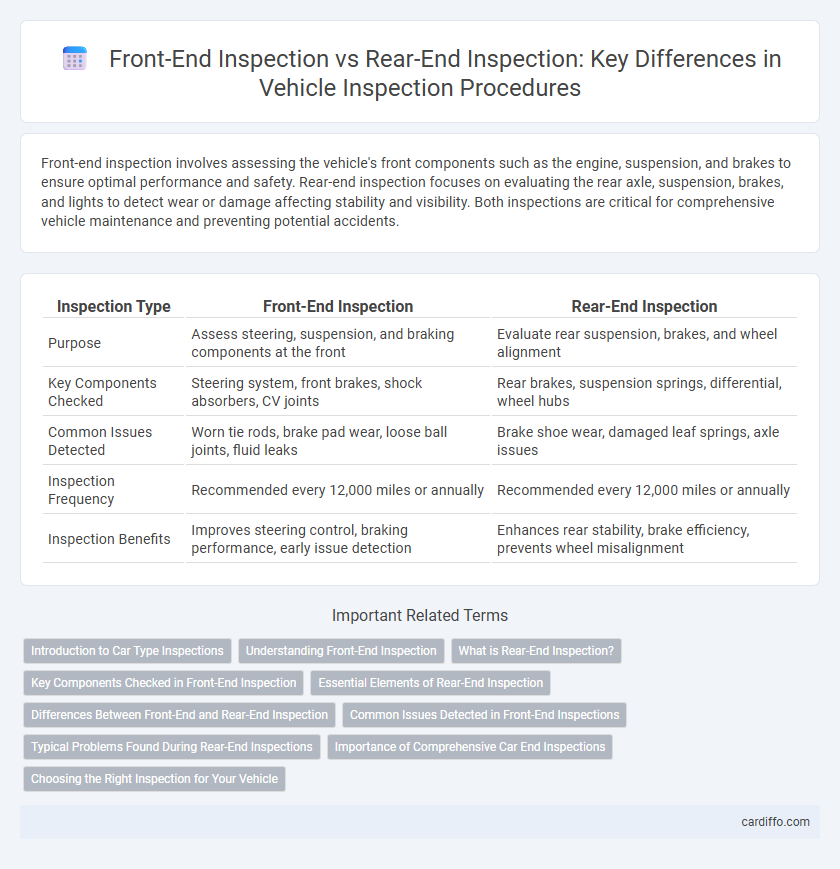Front-end inspection involves assessing the vehicle's front components such as the engine, suspension, and brakes to ensure optimal performance and safety. Rear-end inspection focuses on evaluating the rear axle, suspension, brakes, and lights to detect wear or damage affecting stability and visibility. Both inspections are critical for comprehensive vehicle maintenance and preventing potential accidents.
Table of Comparison
| Inspection Type | Front-End Inspection | Rear-End Inspection |
|---|---|---|
| Purpose | Assess steering, suspension, and braking components at the front | Evaluate rear suspension, brakes, and wheel alignment |
| Key Components Checked | Steering system, front brakes, shock absorbers, CV joints | Rear brakes, suspension springs, differential, wheel hubs |
| Common Issues Detected | Worn tie rods, brake pad wear, loose ball joints, fluid leaks | Brake shoe wear, damaged leaf springs, axle issues |
| Inspection Frequency | Recommended every 12,000 miles or annually | Recommended every 12,000 miles or annually |
| Inspection Benefits | Improves steering control, braking performance, early issue detection | Enhances rear stability, brake efficiency, prevents wheel misalignment |
Introduction to Car Type Inspections
Front-end inspection primarily evaluates components such as the engine, radiator, and front suspension to identify issues affecting vehicle performance and safety. Rear-end inspection focuses on the exhaust system, rear suspension, brakes, and lights to ensure proper function and compliance with safety standards. Different car types may require specific front-end or rear-end inspection protocols based on their design and usage, optimizing maintenance and preventive care.
Understanding Front-End Inspection
Front-end inspection focuses on evaluating the structural integrity and alignment of the vehicle's front components, such as the engine, suspension, and steering systems, which are critical for safety and performance. This inspection method uses diagnostic tools and visual assessments to identify potential issues like leaks, worn parts, or damage that could impair vehicle handling. Understanding front-end inspection helps in maintaining optimal vehicle function and preventing costly repairs by addressing problems early.
What is Rear-End Inspection?
Rear-end inspection involves examining the rear components of a vehicle to ensure safety and functionality, including brakes, suspension, and lighting systems. This inspection helps identify wear or damage that could compromise vehicle performance or road safety. Rear-end inspection is crucial for preventing accidents caused by brake failure or faulty rear lights.
Key Components Checked in Front-End Inspection
Front-end inspection primarily focuses on key components such as the engine, radiator, belts, hoses, front suspension, and brake system to ensure optimal vehicle performance and safety. Inspectors also check the condition of the front tires, steering linkage, and headlights for proper alignment and functionality. This detailed examination helps identify wear and damage early, preventing costly repairs and accidents.
Essential Elements of Rear-End Inspection
Rear-end inspection prioritizes critical elements such as brake system functionality, tail light operation, and structural integrity of the rear frame to ensure safety and compliance with regulations. Key components include checking brake pads and discs for wear, verifying the proper illumination and alignment of brake lights and indicators, and assessing rear bumper and chassis conditions for damage or corrosion. These essential steps prevent rear collisions and enhance vehicle performance during deceleration and stopping phases.
Differences Between Front-End and Rear-End Inspection
Front-end inspection primarily focuses on components such as the control arms, tie rods, ball joints, and steering knuckles, which are crucial for steering and handling. Rear-end inspection targets parts like the rear axle, differential, suspension springs, and shock absorbers, essential for vehicle stability and load support. The key differences lie in the specific components examined and their respective impact on vehicle performance and safety.
Common Issues Detected in Front-End Inspections
Front-end inspections commonly detect issues such as worn suspension components, damaged steering linkages, and uneven tire wear due to misalignment. These inspections also reveal problems with brake pads, rotors, and CV joints that affect vehicle handling and safety. Identifying these defects early during front-end inspections helps prevent costly repairs and ensures optimal driving performance.
Typical Problems Found During Rear-End Inspections
Rear-end inspections commonly reveal issues such as worn brake pads, leaking shock absorbers, and damaged wheel bearings, which can compromise vehicle safety and performance. Rust and corrosion on rear suspension components also frequently emerge as critical concerns during these inspections. Detecting and addressing these typical problems early reduces the risk of costly repairs and ensures optimal rear axle functionality.
Importance of Comprehensive Car End Inspections
Comprehensive car end inspections ensure the overall safety and performance of a vehicle by thoroughly evaluating both front-end and rear-end components. Front-end inspections focus on steering, suspension, brakes, and headlights, which are critical for control and visibility, while rear-end inspections assess tail lights, bumper integrity, and rear suspension to prevent accidents and maintain structural safety. Prioritizing a full inspection of both ends reduces the risk of mechanical failures and enhances vehicle durability on the road.
Choosing the Right Inspection for Your Vehicle
Front-end inspection primarily focuses on critical components such as headlights, turn signals, brakes, and engine performance to ensure safe driving conditions and prevent potential hazards. Rear-end inspection emphasizes the functionality of taillights, brake lights, reverse lights, and bumper integrity, which are essential for rear visibility and collision avoidance. Selecting the appropriate inspection depends on your vehicle's age, recent repairs, and specific safety concerns to maintain optimal roadworthiness and compliance with local regulations.
Front-end inspection vs rear-end inspection Infographic

 cardiffo.com
cardiffo.com